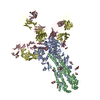+Search query
-Structure paper
| Title | CryoEM Structure of an Influenza Virus Receptor-Binding Site Antibody-Antigen Interface. |
|---|---|
| Journal, issue, pages | J Mol Biol, Vol. 429, Issue 12, Page 1829-1839, Year 2017 |
| Publish date | Jun 16, 2017 |
 Authors Authors | Yuhang Liu / Junhua Pan / Simon Jenni / Donald D Raymond / Tim Caradonna / Khoi T Do / Aaron G Schmidt / Stephen C Harrison / Nikolaus Grigorieff /  |
| PubMed Abstract | Structure-based vaccine design depends on extensive structural analyses of antigen-antibody complexes.Single-particle electron cryomicroscopy (cryoEM) can circumvent some of the problems of x-ray ...Structure-based vaccine design depends on extensive structural analyses of antigen-antibody complexes.Single-particle electron cryomicroscopy (cryoEM) can circumvent some of the problems of x-ray crystallography as a pipeline for obtaining the required structures. We have examined the potential of single-particle cryoEM for determining the structure of influenza-virus hemagglutinin (HA):single-chain variable-domain fragment complexes, by studying a complex we failed to crystallize in pursuing an extended project on the human immune response to influenza vaccines.The result shows that a combination of cryoEM and molecular modeling can yield details of the antigen-antibody interface, although small variation in the twist of the rod-likeHA trimer limited the overall resolution to about 4.5Å.Comparison of principal 3D classes suggests ways to modify the HA trimer to overcome this limitation. A closely related antibody from the same donor did yield crystals when bound with the same HA, giving us an independent validation of the cryoEM results.The two structures also augment our understanding of receptor-binding site recognition by antibodies that neutralize a wide range of influenza-virus variants. |
 External links External links |  J Mol Biol / J Mol Biol /  PubMed:28506635 / PubMed:28506635 /  PubMed Central PubMed Central |
| Methods | EM (single particle) / X-ray diffraction |
| Resolution | 3.4 - 4.8 Å |
| Structure data | EMDB-8561, PDB-5ujz: EMDB-8562, PDB-5uk0: EMDB-8563, PDB-5uk1: EMDB-8564, PDB-5uk2:  PDB-5ug0: |
| Chemicals |  ChemComp-NAG: |
| Source |
|
 Keywords Keywords | VIRAL PROTEIN/IMMUNE SYSTEM / Influenza HA / antibody / complex / VIRAL PROTEIN-IMMUNE SYSTEM complex / Viral glycoprotein / Hemagglutinin / Antibody fragment |
 Movie
Movie Controller
Controller Structure viewers
Structure viewers About Yorodumi Papers
About Yorodumi Papers











 influenza a virus (a/solomon islands/3/2006(h1n1))
influenza a virus (a/solomon islands/3/2006(h1n1)) influenza a virus
influenza a virus homo sapiens (human)
homo sapiens (human)